key BUICK CENTURY 2004 User Guide
[x] Cancel search | Manufacturer: BUICK, Model Year: 2004, Model line: CENTURY, Model: BUICK CENTURY 2004Pages: 358, PDF Size: 4.01 MB
Page 74 of 358
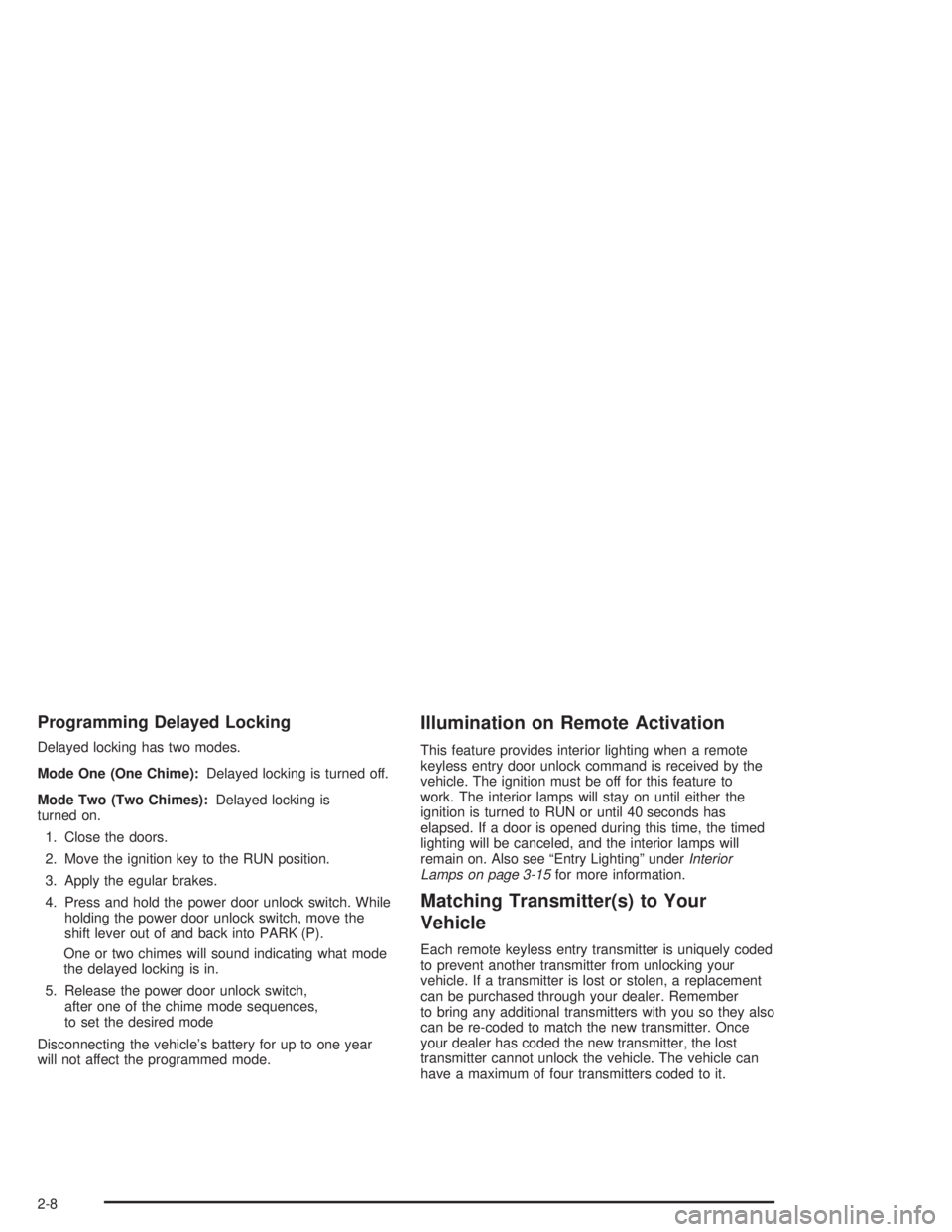
Programming Delayed Locking
Delayed locking has two modes.
Mode One (One Chime):Delayed locking is turned off.
Mode Two (Two Chimes):Delayed locking is
turned on.
1. Close the doors.
2. Move the ignition key to the RUN position.
3. Apply the egular brakes.
4. Press and hold the power door unlock switch. While
holding the power door unlock switch, move the
shift lever out of and back into PARK (P).
One or two chimes will sound indicating what mode
the delayed locking is in.
5. Release the power door unlock switch,
after one of the chime mode sequences,
to set the desired mode
Disconnecting the vehicle’s battery for up to one year
will not affect the programmed mode.
Illumination on Remote Activation
This feature provides interior lighting when a remote
keyless entry door unlock command is received by the
vehicle. The ignition must be off for this feature to
work. The interior lamps will stay on until either the
ignition is turned to RUN or until 40 seconds has
elapsed. If a door is opened during this time, the timed
lighting will be canceled, and the interior lamps will
remain on. Also see “Entry Lighting” underInterior
Lamps on page 3-15for more information.
Matching Transmitter(s) to Your
Vehicle
Each remote keyless entry transmitter is uniquely coded
to prevent another transmitter from unlocking your
vehicle. If a transmitter is lost or stolen, a replacement
can be purchased through your dealer. Remember
to bring any additional transmitters with you so they also
can be re-coded to match the new transmitter. Once
your dealer has coded the new transmitter, the lost
transmitter cannot unlock the vehicle. The vehicle can
have a maximum of four transmitters coded to it.
2-8
Page 75 of 358
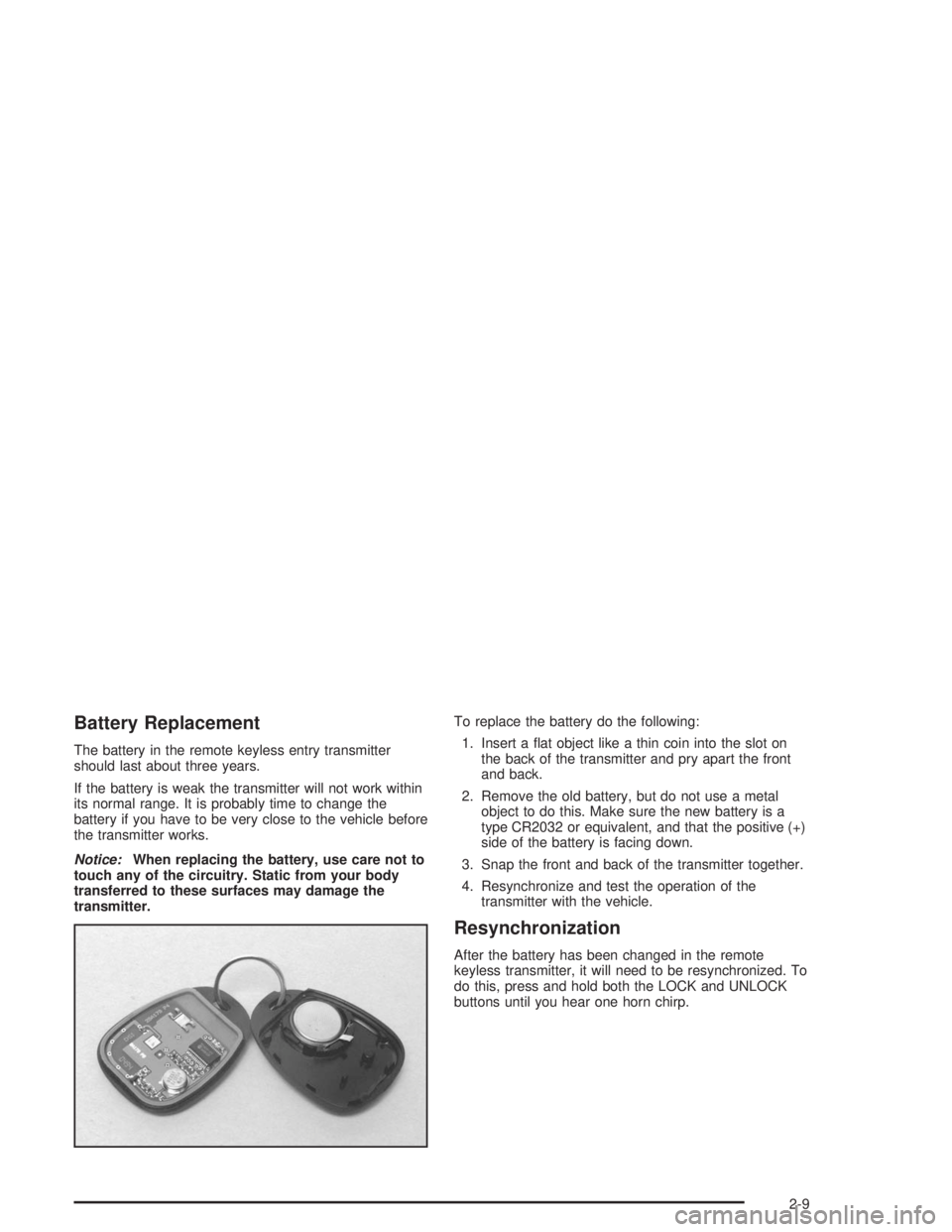
Battery Replacement
The battery in the remote keyless entry transmitter
should last about three years.
If the battery is weak the transmitter will not work within
its normal range. It is probably time to change the
battery if you have to be very close to the vehicle before
the transmitter works.
Notice:When replacing the battery, use care not to
touch any of the circuitry. Static from your body
transferred to these surfaces may damage the
transmitter.To replace the battery do the following:
1. Insert a �at object like a thin coin into the slot on
the back of the transmitter and pry apart the front
and back.
2. Remove the old battery, but do not use a metal
object to do this. Make sure the new battery is a
type CR2032 or equivalent, and that the positive (+)
side of the battery is facing down.
3. Snap the front and back of the transmitter together.
4. Resynchronize and test the operation of the
transmitter with the vehicle.
Resynchronization
After the battery has been changed in the remote
keyless transmitter, it will need to be resynchronized. To
do this, press and hold both the LOCK and UNLOCK
buttons until you hear one horn chirp.
2-9
Page 76 of 358

Doors and Locks
Door Locks
{CAUTION:
Unlocked doors can be dangerous.
Passengers — especially children — can
easily open the doors and fall out of a
moving vehicle. When a door is locked, the
handle will not open it. You increase the
chance of being thrown out of the vehicle
in a crash if the doors are not locked. So,
wear safety belts properly and lock the
doors whenever you drive.
Young children who get into unlocked
vehicles may be unable to get out. A child
can be overcome by extreme heat and can
suffer permanent injuries or even death
from heat stroke. Always lock your vehicle
whenever you leave it.
Outsiders can easily enter through an
unlocked door when you slow down or
stop your vehicle. Locking your doors can
help prevent this from happening.There are several ways to lock and unlock the vehicle.
From the outside, use the door key or remote keyless
entry transmitter. From the inside use the manual
or power door locks.
To manually lock or unlock the driver’s door from the
outside, insert the key and turn it clockwise or
counterclockwise.
To lock or unlock the doors from the inside, push the
manual lock lever forward or rearward.
2-10
Page 78 of 358
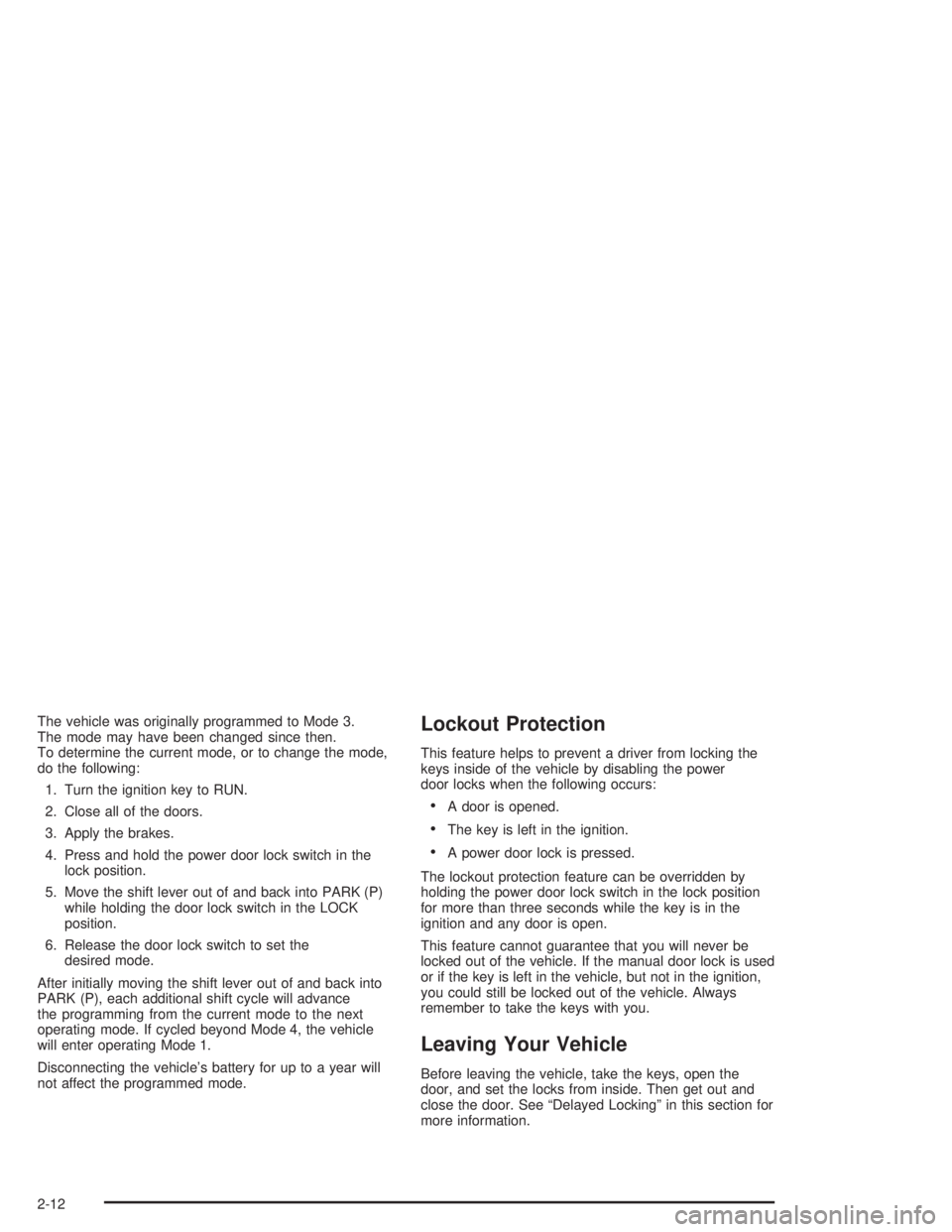
The vehicle was originally programmed to Mode 3.
The mode may have been changed since then.
To determine the current mode, or to change the mode,
do the following:
1. Turn the ignition key to RUN.
2. Close all of the doors.
3. Apply the brakes.
4. Press and hold the power door lock switch in the
lock position.
5. Move the shift lever out of and back into PARK (P)
while holding the door lock switch in the LOCK
position.
6. Release the door lock switch to set the
desired mode.
After initially moving the shift lever out of and back into
PARK (P), each additional shift cycle will advance
the programming from the current mode to the next
operating mode. If cycled beyond Mode 4, the vehicle
will enter operating Mode 1.
Disconnecting the vehicle’s battery for up to a year will
not affect the programmed mode.Lockout Protection
This feature helps to prevent a driver from locking the
keys inside of the vehicle by disabling the power
door locks when the following occurs:
A door is opened.
The key is left in the ignition.
A power door lock is pressed.
The lockout protection feature can be overridden by
holding the power door lock switch in the lock position
for more than three seconds while the key is in the
ignition and any door is open.
This feature cannot guarantee that you will never be
locked out of the vehicle. If the manual door lock is used
or if the key is left in the vehicle, but not in the ignition,
you could still be locked out of the vehicle. Always
remember to take the keys with you.
Leaving Your Vehicle
Before leaving the vehicle, take the keys, open the
door, and set the locks from inside. Then get out and
close the door. See “Delayed Locking” in this section for
more information.
2-12
Page 79 of 358

Trunk
{CAUTION:
It can be dangerous to drive with the trunk lid
open because carbon monoxide (CO) gas can
come into your vehicle. You can not see or
smell CO. It can cause unconsciousness and
even death. If you must drive with the trunk lid
open or if electrical wiring or other cable
connections must pass through the seal
between the body and the trunk lid:
Make sure all other windows are shut.
Turn the fan on your heating or cooling
system to its highest speed and select the
control setting that will force outside air
into your vehicle. See Climate Control
System in the Index.
If you have air outlets on or under the
instrument panel, open them all the way.
SeeEngine Exhaust on page 2-29.
Trunk Lock
To unlock the trunk lid from the outside, insert the door
key into the trunk lock and turn it counterclockwise.
Or, with the vehicle in PARK (P), press the open trunk
symbol on the remote keyless entry transmitter.
Remote Trunk Release
Press the remote trunk
release button located
behind the glove box door
to release the trunk lid
from inside the vehicle.
The shift lever must be in PARK (P), but the key does
not have to be in the ignition for the remote trunk
lid release button to work.
2-13
Page 83 of 358

Sun Visors
To block out glare, swing down the sun visors. They
can also be moved to the side windows. The sun visors
also have extenders that can be pulled out for added
coverage.
Visor Vanity Mirror
Open the cover on the sun visor to expose the
vanity mirror.
Lighted Visor Vanity Mirrors
If the vehicle has the lighted vanity mirrors, the lamps
come on when the cover is opened.
Theft-Deterrent Systems
Vehicle theft is big business, especially in some cities.
Although your vehicle has a number of theft-deterrent
features, we know that nothing we put on it can make it
impossible to steal. However, there are ways you
can help.
PASS-Key®II
The vehicle is equipped
with the PASS-Key®II
(Personalized Automotive
Security System)
theft-deterrent system.
PASS-Key
®II is a passive
theft-deterrent system.
It works when the ignition
key is inserted or
removed from the ignition.
PASS-Key
®II uses a resistor pellet in the ignition key
that matches a decoder in the vehicle.
When the PASS-Key
®II system senses that the wrong
key has been inserted into the ignition, it shuts down
the vehicle’s starter and fuel systems. The starter will not
work and fuel will not go to the engine for about three
minutes. If someone tries to start the vehicle again with
the wrong key, or uses another incorrect key during
this time, the vehicle will not start. This discourages
someone from randomly trying keys with different
resistor pellets in an attempt to make a match.
2-17
Page 84 of 358
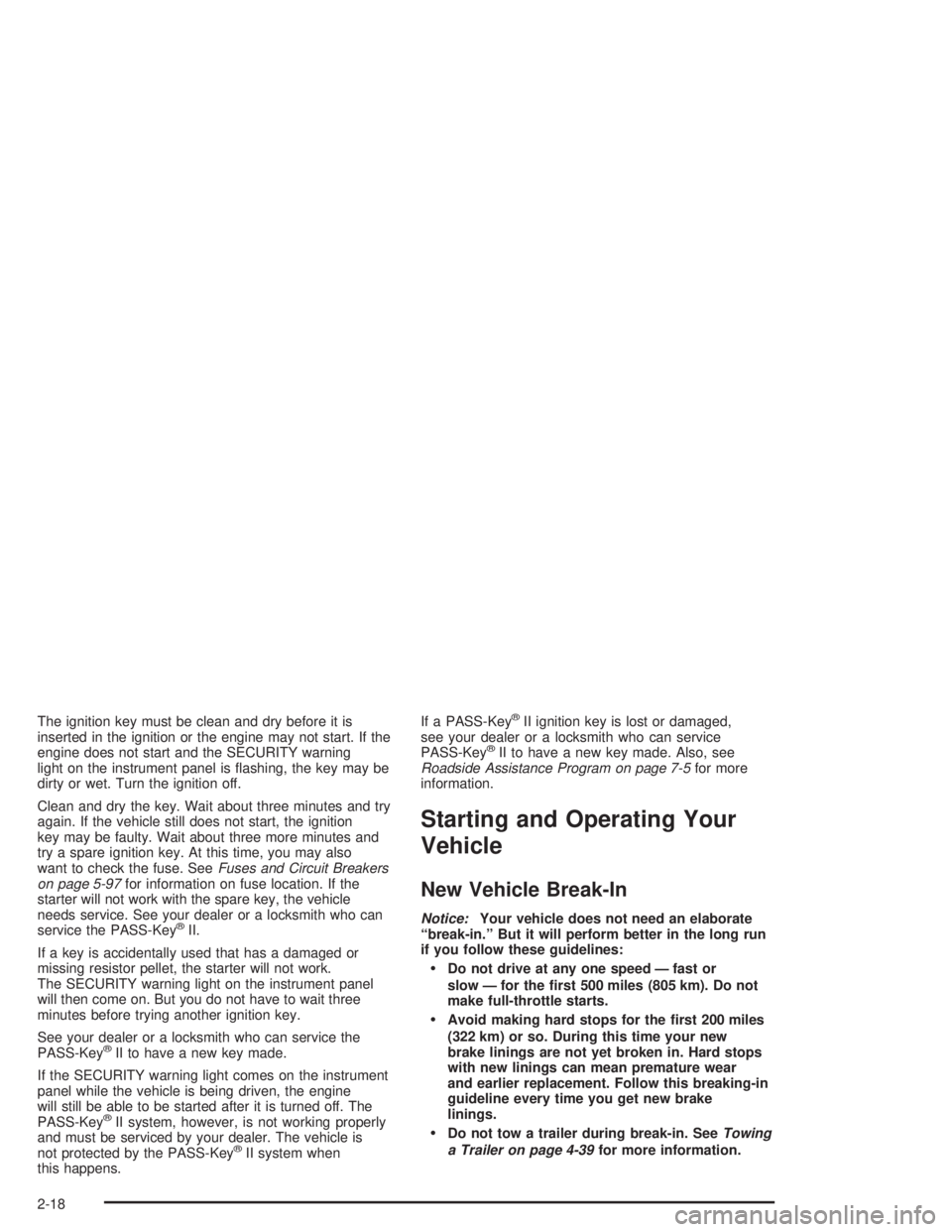
The ignition key must be clean and dry before it is
inserted in the ignition or the engine may not start. If the
engine does not start and the SECURITY warning
light on the instrument panel is �ashing, the key may be
dirty or wet. Turn the ignition off.
Clean and dry the key. Wait about three minutes and try
again. If the vehicle still does not start, the ignition
key may be faulty. Wait about three more minutes and
try a spare ignition key. At this time, you may also
want to check the fuse. SeeFuses and Circuit Breakers
on page 5-97for information on fuse location. If the
starter will not work with the spare key, the vehicle
needs service. See your dealer or a locksmith who can
service the PASS-Key
®II.
If a key is accidentally used that has a damaged or
missing resistor pellet, the starter will not work.
The SECURITY warning light on the instrument panel
will then come on. But you do not have to wait three
minutes before trying another ignition key.
See your dealer or a locksmith who can service the
PASS-Key
®II to have a new key made.
If the SECURITY warning light comes on the instrument
panel while the vehicle is being driven, the engine
will still be able to be started after it is turned off. The
PASS-Key
®II system, however, is not working properly
and must be serviced by your dealer. The vehicle is
not protected by the PASS-Key
®II system when
this happens.If a PASS-Key
®II ignition key is lost or damaged,
see your dealer or a locksmith who can service
PASS-Key
®II to have a new key made. Also, see
Roadside Assistance Program on page 7-5for more
information.
Starting and Operating Your
Vehicle
New Vehicle Break-In
Notice:Your vehicle does not need an elaborate
“break-in.” But it will perform better in the long run
if you follow these guidelines:
Do not drive at any one speed — fast or
slow — for the �rst 500 miles (805 km). Do not
make full-throttle starts.
Avoid making hard stops for the �rst 200 miles
(322 km) or so. During this time your new
brake linings are not yet broken in. Hard stops
with new linings can mean premature wear
and earlier replacement. Follow this breaking-in
guideline every time you get new brake
linings.
Do not tow a trailer during break-in. SeeTowing
a Trailer on page 4-39for more information.
2-18
Page 85 of 358
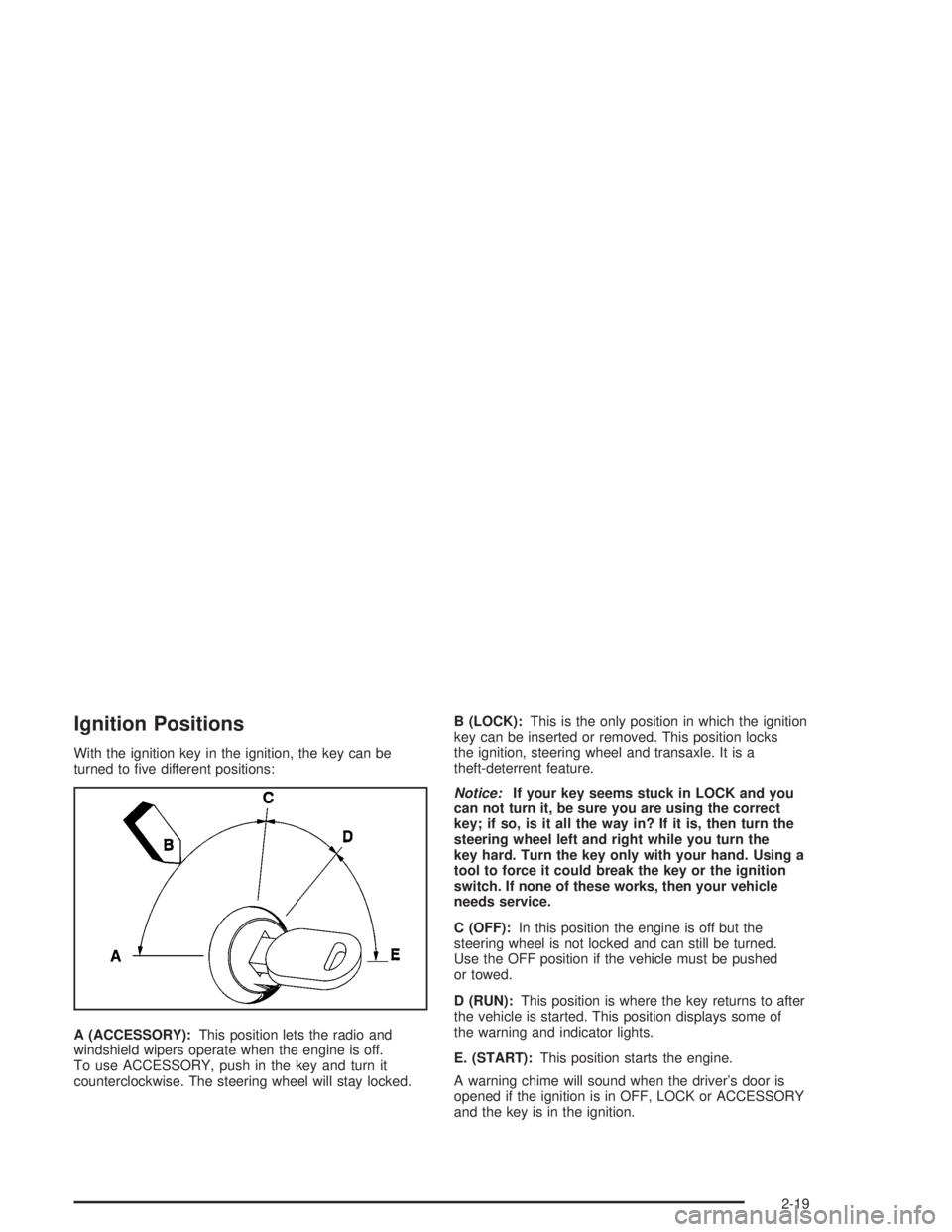
Ignition Positions
With the ignition key in the ignition, the key can be
turned to �ve different positions:
A (ACCESSORY):This position lets the radio and
windshield wipers operate when the engine is off.
To use ACCESSORY, push in the key and turn it
counterclockwise. The steering wheel will stay locked.B (LOCK):This is the only position in which the ignition
key can be inserted or removed. This position locks
the ignition, steering wheel and transaxle. It is a
theft-deterrent feature.
Notice:If your key seems stuck in LOCK and you
can not turn it, be sure you are using the correct
key; if so, is it all the way in? If it is, then turn the
steering wheel left and right while you turn the
key hard. Turn the key only with your hand. Using a
tool to force it could break the key or the ignition
switch. If none of these works, then your vehicle
needs service.
C (OFF):In this position the engine is off but the
steering wheel is not locked and can still be turned.
Use the OFF position if the vehicle must be pushed
or towed.
D (RUN):This position is where the key returns to after
the vehicle is started. This position displays some of
the warning and indicator lights.
E. (START):This position starts the engine.
A warning chime will sound when the driver’s door is
opened if the ignition is in OFF, LOCK or ACCESSORY
and the key is in the ignition.
2-19
Page 86 of 358

Retained Accessory Power (RAP)
If the vehicle has Retained Accessory Power (RAP), the
power windows and audio system can continue to
operate for up to 10 minutes after the ignition key is
turned to OFF and before any of the doors are opened.
Starting Your Engine
Move the shift lever to PARK (P) or NEUTRAL (N). The
engine will not start in any other position – that is a
safety feature. To restart the vehicle when it is already
moving, use NEUTRAL (N) only.
Notice:Shifting into PARK (P) with the vehicle
moving could damage the transaxle. Shift into
PARK (P) only when your vehicle is stopped.
1. With your foot off the accelerator pedal, turn the
ignition key to START. When the engine starts,
let go of the key. The idle speed will go down as the
engine gets warm.Notice:Holding your key in START for longer than
15 seconds at a time will cause your battery to
be drained much sooner. And the excessive heat
can damage your starter motor. Wait about
15 seconds between each try to help avoid draining
your battery or damaging your starter.
2. If the engine will not start, or starts but then stops,
it could be �ooded with too much gasoline. Try
pushing the accelerator pedal all the way to the �oor
and holding it there as the key is held in START
for not more than 15 seconds at a time. This clears
the extra gasoline from the engine
Notice:Your engine is designed to work with the
electronics in your vehicle. If you add electrical
parts or accessories, you could change the way the
engine operates. Before adding electrical equipment,
check with your dealer. If you do not, your engine
might not perform properly.
2-20
Page 93 of 358

Move the shift lever up as far as it will go.
3. Turn the ignition key to OFF.
4. Remove the key and take it with you. If you can
leave your vehicle with the ignition key in your
hand, the vehicle is in PARK (P).
Leaving Your Vehicle With the Engine
Running
{CAUTION:
It can be dangerous to leave your vehicle with
the engine running. Your vehicle could move
suddenly if the shift lever is not fully in
PARK (P) with the parking brake �rmly set.
And, if you leave the vehicle with the engine
running, it could overheat and even catch �re.
You or others could be injured. Do not leave
your vehicle with the engine running.
If the vehicle is left with the engine running, be sure it is
in PARK (P) and the parking brake is �rmly set before
you leave it. After you have moved the shift lever
into PARK (P), hold the regular brake pedal down. Then,
see if you can move the shift lever out of PARK (P). If
you can, it means that the shift lever was not fully locked
into PARK (P).
2-27